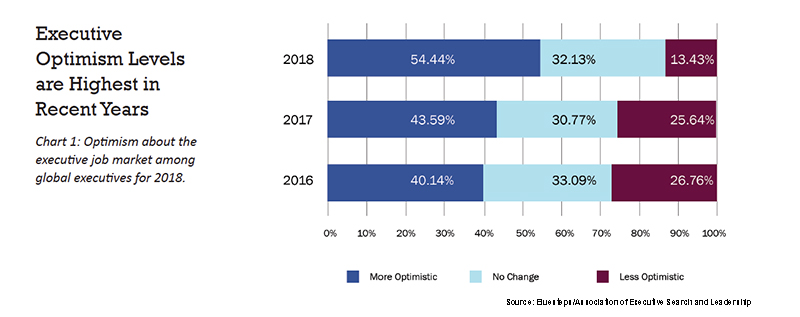
Senior executives are optimistic about the job market. Really optimistic. Ongoing research by BlueSteps, a service of the Association of Executive Search and Leadership Consultants (AESC), shows steadily increasing confidence about the executive job market since 2016. For 2018, nearly 77 percent of the executives surveyed feel that there will be at least the same number of C-level openings this year. 54 percent think openings will increase for those in the executive level job search.1

Turnover activity at the very top is active. Outplacement firm Challenger, Gray, and Christmas, Inc. issues a monthly report on CEO changes at America’s largest companies. For Q1 of 2018, CEO exits were up 16 percent over the previous year. Of particular interest, women are steadily gaining ground in the top positions. 44 transitions involved new women CEOs who replaced male predecessors, outpacing 23 female to male transitions. 2
The Timing is Right. Are you ready to take your Executive Career to the next level?
62 percent of AESC member recruiters agree that there will be strong demand for executives into 2019. The technology sector is hiring. Healthcare and manufacturing are also identified as industries that will be adding more C-level positions.
Strong demand doesn’t necessarily mean that top level jobs are less competitive, though. Top executive jobs represent only 2 percent of the labor force in the U.S. Still, that’s over 2.5 million positions, and one of them could be a fit for you.3
Your career move to an executive position should start with some honest self-evaluation. Today’s C-suites aren’t really designed for the meek and mild. To qualify as a candidate for an executive slot, you’ll need to demonstrate strategic thinking, leadership, creativity, and adaptability. Vision is a mandatory and motive characteristic – you’ll need to show that you can not only see out of the box, but you have the ability to create new boxes. Today’s executives must be technologically adept and demonstrate innate emotional intelligence.
Executive Career Coaching Basics

If you’ve got the stuff, you’re in charge of your career path, but making your next move takes time, planning, and continual effort. Even in a robust economy, it may take 6 months to find your next C-level assignment. Finding your next slot really isn’t just a job search. It’s a career strategy. Practically speaking, utilizing executive career coaching and strategies means you’re always in the market, creating and shaping your next opportunities.
How do you pursue an executive career strategy? In a broad sense, it means weighing options and making things happen. In application, it means continual activity.
Here are 4 critical strategy components:
- Networking – For executive positions, who you know matters. Get involved in your industry and in your community to make contacts. Provide referrals and introductions for others. Volunteer and show up. You’ll make acquaintances that can provide insight and active help as you plan your career moves.
- Company Spotting – Tune in to companies that are possible targets. Seek out contacts and keep up with new developments. You may be able to set up informational interviews to learn more about your target companies. These formal or informal meetings can provide you with a sense of how you might fit in the organization. They also provide your target company with a preview of your talents and capability.
- Recruiters – Staying in touch with industry or area recruiters is a good idea. With high competition for top performing leaders, businesses turn frequently to executive recruiters for their expertise and their contacts. If the best recruiters know you’re out there, they’ll call when the right position comes along.
- Visibility – Mind your profiles and your online presence. Your LinkedIn profile is your online resume. It’s also a good place to engage with others who are “thought leaders” in your field.
Your Executive Resume is your Brand Statement
In a very real sense your executive career strategy builds your brand. You’ll also need a very strong personal brand statement. That’s your resume. It presents a unique value proposition with selling points that emphasize your accomplishments and show what you can do.
In two pages, you’ll either stand out or get screened out. Your executive resume represents the required credentials that will get you into the interview for the executive position you want. It can also help you to “set up” the interview with selected stories that demonstrate your abilities and help your next company to predict your future performance.

Nailing the Executive Job Interview
Your resume and the effectiveness of your executive career strategy will certainly help get you into an interview, but you still have the opportunity to blow it. Nailing the interview is an obvious part of your strategy and the information and contacts you’ve already made will come into play. For the interview, you’ll need to be smart about the specifics. Details and careful preparation are important. Nailing the interview involves tactics.
Here are six tactical suggestions:
- Review Your Research and Fill in the Gaps – You should have a thorough knowledge of your target company, including initiatives, needs, products, and opportunities.
- Identify the Decision Makers – It’s important to have some knowledge of the key players in the organization. You’ll also want to ask who will be involved in the interview process. Use your networks to do some research and get a sense of the people you’ll talk with and their points of view.
- Develop your Selling Points – There are two simple decision drivers for your target company. They want to hire the candidate with the best capabilities and the strongest fit with their organization. Fit doesn’t necessarily mean fitting in to the existing organization, but being able to lead in new directions. Your resume provides a preview of your potential performance. You’ll want to develop stories that illustrate your accomplishments and describe the leadership role that you’re likely to take.
- Practice – Be prepared for multiple interviews in various formats. The sequence of interviews could include phone and video screening, panel interviews, meetings over dinner, and one on one. (Take a look at our article about Warming Up for a Job Interview.)
- Prepare Questions and Take Notes – Prepare your questions ahead of time. Make notes during the interviews, if appropriate, or shortly thereafter. You’ll want to follow up with more questions in subsequent meetings.
- End on a High Point – Recap, let your enthusiasm show, and lead carefully to set the stage for the next step in the process. Always say thank you and send a handwritten note if it’s appropriate.
Executive Resumes, Interview Coaching Services, and More – CareerPro Global provides Professional Assistance with Your Executive Career Strategy
The stakes are higher at the C-level, both for you and for the company that selects you for a leadership position. Getting an objective, professional assessment of your executive career strategy and tactics can be a very good investment. CareerPro Global can assist with executive job career coaching, executive interview coaching, and development of custom executive resumes for the positions you target.
The timing is right for your next executive career move. CareerPro Global’s executive services can be an important part of your C-level strategy. For over three decades, we’ve worked with C-Suite execs to prepare resumes and help with preparation for interviews that move them up the corporate ladder. If you’d like to learn more, just get in touch for a free consultation.
Sources:
1 2018 BlueSteps Executive Career Outlook, Association of Executive Search and Leadership Consultants, 2018,
2 2018 March CEO Report , Challenger, Gray and Christmas, Inc., 3/18/18.
3 Occupational Outlook Handbook, Bureau of Labor Statistics, 2016.
Photo Credits: Pexels.com
Learn More About Corporate & Executive Resumes




